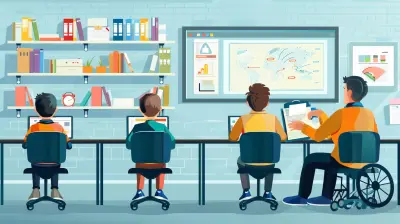The Future of Textbooks: eBooks, Interactive Content, and More
21 October 2025
Remember the days of lugging around a backpack stuffed with heavy textbooks, pages crinkled, covers worn, and your back practically begging for mercy? Yeah, same here. Those brick-like books were once the standard, the backbone of education. But times are changing—and fast. The future of textbooks is looking brighter, lighter, smarter, and surprisingly more fun.
Today, we’re diving deep into what’s next for educational materials and why you might want to trade in that stack of books for a sleek tablet—or something even cooler.
From Paper to Pixels: How Textbooks Are Changing
Textbooks are experiencing a digital revolution, and it's not just about turning paper pages into PDFs. We're talking about fully immersive, interactive, and personalized learning experiences. Think eBooks, augmented reality, gamified content, and even AI-powered tutors all built right into your study materials.Why is this happening? Simple—technology is evolving, and students (along with educators) are craving smarter ways to learn. We're no longer satisfied with static pages filled with blocky paragraphs. We want learning to come alive.
eBooks: The Digital Textbook Movement
Let’s start with the big one—eBooks. They're not exactly new, but they’ve come a long way since the early days of clunky PDF readers.Why eBooks Are Taking Over
- Portability: Hundreds of textbooks in one device? Yes, please.- Instant Access: No more waiting for the bookstore to stock up—or worse, shipping delays.
- Searchability: Need to find that one paragraph on photosynthesis fast? Ctrl+F is your best friend.
- Cost-Effective: In many cases, eBooks are cheaper than physical versions. Plus, no printing or shipping costs.
- Environmentally Friendly: Less paper means fewer trees chopped down. Mother Earth gives it a thumbs up.
And let's be honest—studying on a tablet or laptop just feels more modern. You can highlight, take digital notes, and even have your eBook read out loud to you. Welcome to the future.
Interactive Content: Learning That Comes Alive
Now we're getting into the really cool stuff. Textbooks aren't just books anymore—they're becoming full-on learning experiences.What Is Interactive Content?
In short, it’s content that responds to you. Instead of passively reading a chapter about photosynthesis, imagine dragging molecules around, watching animations of sunlight hitting leaves, and taking quizzes that change based on your answers. That’s interactive learning.Types of Interactive Textbook Features
- Embedded Videos and Animations: Visual learners, rejoice.- Quizzes and Feedback: Learn, test, and improve—all in real time.
- Gamification: Turn lessons into games. Who said studying can’t be fun?
- Augmented Reality (AR): Point your phone at a page, and watch 3D models spring to life.
- Simulations and Labs: Conduct virtual science experiments or economic models without stepping into a lab.
This stuff isn't just flashy—it actually helps you learn better. Studies show that interactive content boosts engagement, retention, and even motivation.
Adaptive Learning: Education Tailored Just for You
Ever feel like your textbook doesn’t get you? Like it's moving too fast, too slow, or just not clicking? That’s where adaptive learning comes in.What Is Adaptive Learning?
Think of it as a textbook with a brain. These tools use artificial intelligence to adjust content based on how you're doing. Struggling with a concept? It’ll slow down, offer extra practice, or explain it in a different way. Breezing through a topic? You’ll get more challenging material to keep you sharp.It’s like having a personal tutor built right into your book.
Collaboration in the Cloud: Social and Shared Learning
Another cool feature of modern textbooks? They're connected. With cloud-based platforms, students and teachers can interact directly within the textbook.Benefits of Cloud-Based Learning Tools
- Instant Feedback from Teachers: Get help fast.- Collaborative Notes and Highlights: Share insights with classmates in real time.
- Discussion Boards and Comments: Ask questions, start conversations, and deepen your understanding.
This makes learning more social, which, let’s face it, is how we humans learn best. We’re not meant to be isolated brains in silence—we learn through conversation, collaboration, and community.
The Rise of Open Educational Resources (OER)
What if we told you that many of these future-friendly textbooks are not only interactive and smart—but free?What Are Open Educational Resources?
OER are teaching materials that are in the public domain or licensed for free use. These digital textbooks are often created by universities, educators, or nonprofit organizations and are available to anyone.Why OER Is a Game-Changer
- Accessibility: Students everywhere, regardless of income, can get high-quality materials.- Customizability: Teachers can tweak, mix, and match content to fit their curriculum perfectly.
- Up-to-Date Content: Unlike traditional textbooks that might go years without updates, OER can be refreshed in real time.
In a world where textbook costs have been skyrocketing, this is a breath of fresh air.
The Role of AI and Machine Learning in Future Textbooks
We touched on adaptive learning already, but let’s zoom out. AI isn’t just personalizing your path—it’s fundamentally reshaping what textbooks can do.How AI Is Shaping the Learning Experience
- Smart Summaries: Quickly condense chapters into digestible nuggets.- Voice Interaction: Ask your textbook questions and get answers, Siri-style.
- Predictive Learning Paths: AI can suggest what to study next based on your progress and goals.
- Real-Time Translations: Multilingual students can switch between languages instantly.
We’re talking about learning materials that respond, evolve, and grow with you. It's like the textbook stepped out of the page and became your study partner.
Are Traditional Textbooks Truly Going Extinct?
Let’s put down the digital excitement for a second. All this new tech sounds amazing, but does that mean the printed textbook is on its last breath?Not necessarily.
The Case for Physical Books
- Tactile Experience: Some learners just focus better with physical pages.- No Tech Needed: No batteries, no software updates, no distractions.
- Eye Health & Screen Fatigue: A real concern—sometimes you just want a break from screens.
So maybe it’s not about replacing physical textbooks but complementing them. We might be heading toward a hybrid model—digital when it's helpful, physical when it makes sense.
Challenges of the Digital Textbook Era
It’s not all sunshine and tech rainbows. There are some real challenges we need to face.Common Issues with eLearning Materials
- Screen Time Overload: So many digital tools can lead to burnout.- Access Inequality: Not every student has a reliable device or internet connection.
- Digital Distraction: Let's be honest—TikTok is just one click away.
- Learning Curve: Some students and teachers aren’t tech-savvy and may struggle with complex platforms.
That’s why any shift toward digital textbooks needs to be thoughtful, inclusive, and flexible.
The Future Is Now: What’s Next for Educational Content?
We’re at a tipping point. The future of textbooks is not some far-off dream. It’s happening right now, all around us.What to Watch in the Coming Years
- Virtual Reality Classrooms: Immersive learning environments that feel like teleportation.- Blockchain Credentials: Secure, verifiable proof of learning and credentials.
- Voice-Activated Learning: Like having a conversation with your textbook.
- Fully AI-Generated Courses: Curriculum built by and for machine learning systems tailored to your pace and style.
It may sound futuristic, but in just a few years, these ideas could be the norm.
How You Can Prepare for the Future of Textbooks
Feeling a little overwhelmed? Don’t be. Here’s how to get ahead of the game and embrace the new wave of learning:Tips for Students
- Start with Hybrid Learning: Use both physical and digital tools to see what works best for you.- Explore Open Resources: Sites like Khan Academy or OpenStax are full of free resources.
- Use Tech Wisely: Switch off notifications and create focused study sessions.
- Ask Your Teachers: They’re learning too! Share tips and tools.
Tips for Educators
- Experiment Slowly: Start by adding one new interactive tool to your class.- Get Training: Many platforms offer free demos and workshops.
- Listen to Students: They’ll tell you what’s working and what’s not.
- Collaborate with Peers: Share resources, best practices, and inspiration.
Final Thoughts: The Book Isn't Dead—It's Just Getting Smarter
The future of textbooks isn't about saying goodbye to learning as we know it—it's about saying hello to new possibilities. With eBooks, interactive content, and cutting-edge tools, education is becoming more engaging, personalized, and accessible than ever before.Sure, there's a learning curve (pun intended), and we’ll bump into a few challenges along the way. But if we lean into the change, stay curious, and keep the focus on helping learners truly understand and enjoy what they’re learning, the future looks incredibly bright.
So whether you're a student, a teacher, or just a lifelong learner, buckle up. The textbook of the future isn’t just something you read—it’s something you experience.
all images in this post were generated using AI tools
Category:
Educational TechnologyAuthor:

Anita Harmon
Discussion
rate this article
1 comments
Parker Spencer
Exciting insights on the evolution of textbooks! Embracing eBooks and interactive content will revolutionize learning experiences for future generations.
October 26, 2025 at 4:57 AM

Anita Harmon
Thank you! I'm glad you found the insights valuable. Embracing technology truly has the potential to transform learning!


